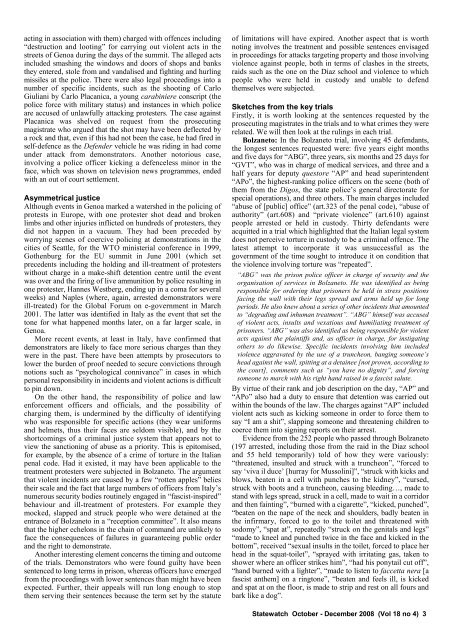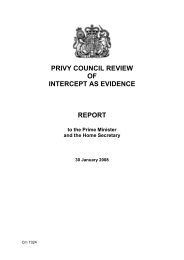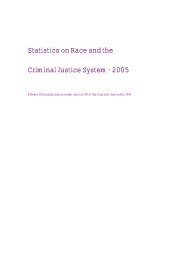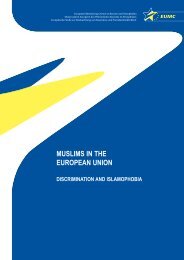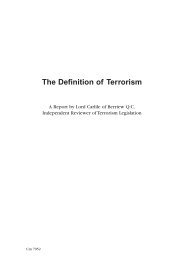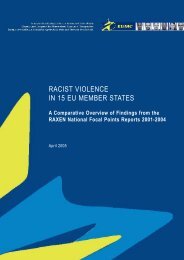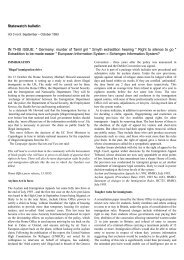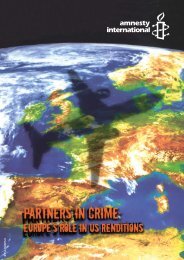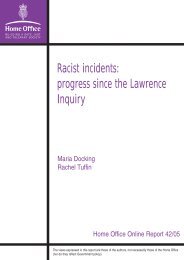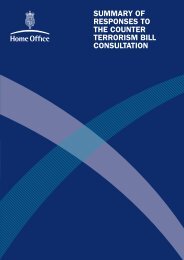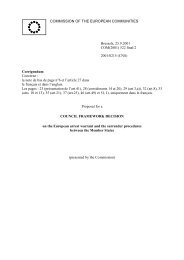Vol 18 no 4 - Statewatch
Vol 18 no 4 - Statewatch
Vol 18 no 4 - Statewatch
You also want an ePaper? Increase the reach of your titles
YUMPU automatically turns print PDFs into web optimized ePapers that Google loves.
acting in association with them) charged with offences including<br />
“destruction and looting” for carrying out violent acts in the<br />
streets of Ge<strong>no</strong>a during the days of the summit. The alleged acts<br />
included smashing the windows and doors of shops and banks<br />
they entered, stole from and vandalised and fighting and hurling<br />
missiles at the police. There were also legal proceedings into a<br />
number of specific incidents, such as the shooting of Carlo<br />
Giuliani by Carlo Placanica, a young carabiniere conscript (the<br />
police force with military status) and instances in which police<br />
are accused of unlawfully attacking protesters. The case against<br />
Placanica was shelved on request from the prosecuting<br />
magistrate who argued that the shot may have been deflected by<br />
a rock and that, even if this had <strong>no</strong>t been the case, he had fired in<br />
self-defence as the Defender vehicle he was riding in had come<br />
under attack from demonstrators. A<strong>no</strong>ther <strong>no</strong>torious case,<br />
involving a police officer kicking a defenceless mi<strong>no</strong>r in the<br />
face, which was shown on television news programmes, ended<br />
with an out of court settlement.<br />
Asymmetrical justice<br />
Although events in Ge<strong>no</strong>a marked a watershed in the policing of<br />
protests in Europe, with one protester shot dead and broken<br />
limbs and other injuries inflicted on hundreds of protesters, they<br />
did <strong>no</strong>t happen in a vacuum. They had been preceded by<br />
worrying scenes of coercive policing at demonstrations in the<br />
cities of Seattle, for the WTO ministerial conference in 1999,<br />
Gothenburg for the EU summit in June 2001 (which set<br />
precedents including the holding and ill-treatment of protesters<br />
without charge in a make-shift detention centre until the event<br />
was over and the firing of live ammunition by police resulting in<br />
one protester, Hannes Westberg, ending up in a coma for several<br />
weeks) and Naples (where, again, arrested demonstrators were<br />
ill-treated) for the Global Forum on e-government in March<br />
2001. The latter was identified in Italy as the event that set the<br />
tone for what happened months later, on a far larger scale, in<br />
Ge<strong>no</strong>a.<br />
More recent events, at least in Italy, have confirmed that<br />
demonstrators are likely to face more serious charges than they<br />
were in the past. There have been attempts by prosecutors to<br />
lower the burden of proof needed to secure convictions through<br />
<strong>no</strong>tions such as “psychological connivance” in cases in which<br />
personal responsibility in incidents and violent actions is difficult<br />
to pin down.<br />
On the other hand, the responsibility of police and law<br />
enforcement officers and officials, and the possibility of<br />
charging them, is undermined by the difficulty of identifying<br />
who was responsible for specific actions (they wear uniforms<br />
and helmets, thus their faces are seldom visible), and by the<br />
shortcomings of a criminal justice system that appears <strong>no</strong>t to<br />
view the sanctioning of abuse as a priority. This is epitomised,<br />
for example, by the absence of a crime of torture in the Italian<br />
penal code. Had it existed, it may have been applicable to the<br />
treatment protesters were subjected in Bolzaneto. The argument<br />
that violent incidents are caused by a few “rotten apples” belies<br />
their scale and the fact that large numbers of officers from Italy’s<br />
numerous security bodies routinely engaged in “fascist-inspired”<br />
behaviour and ill-treatment of protesters. For example they<br />
mocked, slapped and struck people who were detained at the<br />
entrance of Bolzaneto in a “reception committee”. It also means<br />
that the higher echelons in the chain of command are unlikely to<br />
face the consequences of failures in guaranteeing public order<br />
and the right to demonstrate.<br />
A<strong>no</strong>ther interesting element concerns the timing and outcome<br />
of the trials. Demonstrators who were found guilty have been<br />
sentenced to long terms in prison, whereas officers have emerged<br />
from the proceedings with lower sentences than might have been<br />
expected. Further, their appeals will run long e<strong>no</strong>ugh to stop<br />
them serving their sentences because the term set by the statute<br />
of limitations will have expired. A<strong>no</strong>ther aspect that is worth<br />
<strong>no</strong>ting involves the treatment and possible sentences envisaged<br />
in proceedings for attacks targeting property and those involving<br />
violence against people, both in terms of clashes in the streets,<br />
raids such as the one on the Diaz school and violence to which<br />
people who were held in custody and unable to defend<br />
themselves were subjected.<br />
Sketches from the key trials<br />
Firstly, it is worth looking at the sentences requested by the<br />
prosecuting magistrates in the trials and to what crimes they were<br />
related. We will then look at the rulings in each trial.<br />
Bolzaneto: In the Bolzaneto trial, involving 45 defendants,<br />
the longest sentences requested were: five years eight months<br />
and five days for “ABG”, three years, six months and 25 days for<br />
“GVT”, who was in charge of medical services, and three and a<br />
half years for deputy questore “AP” and head superintendent<br />
“APo”, the highest-ranking police officers on the scene (both of<br />
them from the Digos, the state police’s general directorate for<br />
special operations), and three others. The main charges included<br />
“abuse of [public] office” (art.323 of the penal code), “abuse of<br />
authority” (art.608) and “private violence” (art.610) against<br />
people arrested or held in custody. Thirty defendants were<br />
acquitted in a trial which highlighted that the Italian legal system<br />
does <strong>no</strong>t perceive torture in custody to be a criminal offence. The<br />
latest attempt to incorporate it was unsuccessful as the<br />
government of the time sought to introduce it on condition that<br />
the violence involving torture was “repeated”.<br />
“ABG” was the prison police officer in charge of security and the<br />
organisation of services in Bolzaneto. He was identified as being<br />
responsible for ordering that prisoners be held in stress positions<br />
facing the wall with their legs spread and arms held up for long<br />
periods. He also knew about a series of other incidents that amounted<br />
to “degrading and inhuman treatment”. “ABG” himself was accused<br />
of violent acts, insults and vexatious and humiliating treatment of<br />
prisoners. “ABG” was also identified as being responsible for violent<br />
acts against the plaintiffs and, as officer in charge, for instigating<br />
others to do likewise. Specific incidents involving him included<br />
violence aggravated by the use of a truncheon, banging someone’s<br />
head against the wall, spitting at a detainee [<strong>no</strong>t proven, according to<br />
the court], comments such as “you have <strong>no</strong> dignity”, and forcing<br />
someone to march with his right hand raised in a fascist salute.<br />
By virtue of their rank and job description on the day, “AP” and<br />
“APo” also had a duty to ensure that detention was carried out<br />
within the bounds of the law. The charges against “AP” included<br />
violent acts such as kicking someone in order to force them to<br />
say “I am a shit”, slapping someone and threatening children to<br />
coerce them into signing reports on their arrest.<br />
Evidence from the 252 people who passed through Bolzaneto<br />
(197 arrested, including those from the raid in the Diaz school<br />
and 55 held temporarily) told of how they were variously:<br />
“threatened, insulted and struck with a truncheon”, “forced to<br />
say ‘viva il duce’ [hurray for Mussolini]”, “struck with kicks and<br />
blows, beaten in a cell with punches to the kidney”, “cursed,<br />
struck with boots and a truncheon, causing bleeding…, made to<br />
stand with legs spread, struck in a cell, made to wait in a corridor<br />
and then fainting”, “burned with a cigarette”, “kicked, punched”,<br />
“beaten on the nape of the neck and shoulders, badly beaten in<br />
the infirmary, forced to go to the toilet and threatened with<br />
sodomy”, “spat at”, repeatedly “struck on the genitals and legs”<br />
“made to kneel and punched twice in the face and kicked in the<br />
bottom”, received “sexual insults in the toilet, forced to place her<br />
head in the squat-toilet”, “sprayed with irritating gas, taken to<br />
shower where an officer strikes him”, “had his ponytail cut off”,<br />
“hand burned with a lighter”, “made to listen to faccetta nera [a<br />
fascist anthem] on a ringtone”, “beaten and feels ill, is kicked<br />
and spat at on the floor, is made to strip and rest on all fours and<br />
bark like a dog”.<br />
<strong>Statewatch</strong> October - December 2008 (<strong>Vol</strong> <strong>18</strong> <strong>no</strong> 4) 3


